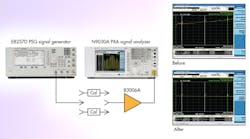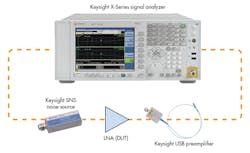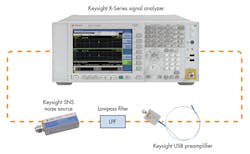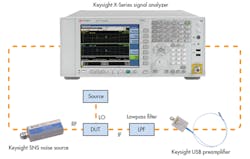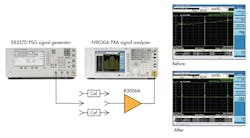Selecting Microwave Amps for Measurements
This file type includes high resolution graphics and schematics when applicable.
Amplifiers may not be the first piece to consider when setting up a test-and-measurement system. Nonetheless, amplifiers can play a major role in many different measurements, raising test signals to required levels and helping to boost the accuracy of the results for RF and microwave analyses.
Of course, amplifiers come in many shapes and sizes, from tiny surface-mount integrated-circuit (IC) amplifiers with low noise figures to larger high-power amplifiers that require heat sinks to maintain acceptable operating temperatures. The focus of this article will be on RF/microwave amplifiers that are well suited for use in test-and-measurement applications.
Many different types of RF/microwave amplifiers are in use in modern applications, falling within two main categories: narrowband and broadband amplifiers. Defining the two categories can be somewhat subjective, since one user’s broadband amplifier may be another user’s narrowband amplifier. Narrowband frequency spans tend to refer to communications channels and can be quite narrow, such as 12.5 and 25.0 kHz.1
Solid-state amplifiers depend on impedance matching of active devices to achieve optimum gain over an operating bandwidth, so some amplifier parameters such as gain and gain flatness with frequency can also be affected by the relative bandwidth of an amplifier. For test-and-measurement applications, narrowband amplifiers are often used for lower-frequency setups, such as from 0.7 to 2.7 GHz. A broadband amplifier for test-and-measurement use may be used to amplify a much wider span of frequencies (e.g., 100 kHz to 50 GHz).
In contrast to narrowband amplifiers, broadband amplifiers must overcome some complex design challenges, such as the need to achieve good impedance matching of the active devices over the broad frequency range. Part of selecting an amplifier for test applications is to keep the price-versus-performance tradeoffs in sight.
For example, the cost of a broadband amplifier may be 20 times that of a narrowband amplifier—operating at a fraction of that bandwidth—but the cost and inconvenience of replacing one broadband amplifier with multiple narrowband amplifiers may not add up. The use of a broadband amplifier can greatly simplify a test setup and lead to optimum performance compared to the required number of narrowband amplifiers to cover the same total bandwidth.
Microwave amplifiers are crucial in measurement systems when testing components (i.e., cellular handsets, antennas, transmitters, and receivers) in communication systems. In applications where adequate RF/microwave signal power is needed to overcome system losses, such as in electromagnetic-interference/electromagnetic-compatibility (EMI/EMC) test systems, a high-performance high-frequency amplifier is required.
Microwave amplifiers are often used with signal generators, spectrum analyzers, and vector network analyzers (VNAs) in high-frequency test systems. For measurement applications that may require higher signal power levels than typically available from test instruments such as signal generators, spectrum analyzers, and VNAs, a system engineer must decide whether the best approach is to select the high-power option for a given test instrument or to use an external power amplifier.
Adding a high-power option to a signal generator may seem like a simple solution, but it results in limited output power with tradeoffs that include increased harmonic levels and higher intermodulation distortion (IMD) compared to the standard model. Generally, a spectrum analyzer can make measurements on input signal levels to +30 dBm (1 W), with a preamplifier option helpful in lowering the noise floor when low-level input signals must be measured.
Signal generators may not provide that +30 dBm on their own, since they generally produce higher output-power levels at lower frequencies—typically around +20 dBm. A VNA will typically provide output levels at around +5 dBm for further analysis.
Choosing an external microwave amplifier with low noise figure and high gain can significantly reduce overall test system noise figure and boost available power for a variety of measurements; this holds true both for broadband and narrowband measurements. Selecting the best amplifier is a matter of reviewing various amplifier performance parameters.
Among these parameters are frequency range; noise figure; output power; gain; input and output return loss or voltage standing wave ratio (VSWR); isolation between channels; phase noise; and matching the performance of an amplifier under consideration to the measurements to be performed. For use with a signal generator and a spectrum analyzer, for example, amplifiers for test can be evaluated by considering these different parameters.
Typical RF/microwave applications range in frequency from 100 MHz (for testing such components as semiconductors and ICs) to 60 GHz and higher [for line-of-sight communications and satellite-communications (satcom) components and systems]. Testing components for wireless communications systems may only call for an amplifier with high-end frequency of 3 or 5 GHz, although specifying an amplifier with broader frequency range increases the flexibility of the test system.
Ideally, the bandwidth of the amplifier matches the frequency range of the signal generator and/or spectrum analyzer in a given test system, although the frequency range for a particular set of measurements will also be application specific. Also, a wider frequency range may be sacrificed for more optimum performance in a narrower bandwidth, especially if price is also a key consideration.
For certain applications, such as evaluating receiver sensitivity, noise figure can be one of the more important specifications when selecting an amplifier for use with a test system. The noise figure is defined as the ratio of the signal-to-noise power ratio (SNR) at the input of the amplifier to the SNR at the output of the amplifier. The noise factor is thus the ratio of actual output noise to that which would remain if the amplifier itself did not introduce noise.
Amplifiers with low noise figures are generally preferred to those with higher noise figures, since a receiver’s performance (in terms of sensitivity) is dominated by the noise figure of the receiver’s preamplifier. For test systems required to measure noise figure, adding a preamplifier can reduce the total system noise figure:
Fnew = G{Fpa + (Fsys – 1)/Fpa}
By adding a preamplifier to noise figure measurement systems, the total system noise figure can also be reduced.
where:
F = the noise figure of the preamplifier, and
G = the gain of the preamplifier, both in linear terms.
In terms of logarithmic value, the system noise figure (NFsys) can be found from the equation:
NFsys = 10log((Fsys) (in dB)
For test systems with a single preamplifier, where the gain of the preamplifier is greater than or equal to the noise figure of the spectrum analyzer, the system noise figure is approximately equal to the noise figure of the preamplifier.
This file type includes high resolution graphics and schematics when applicable.
Assessing Output Power
This file type includes high resolution graphics and schematics when applicable.
Output power is another key specification to review when comparing amplifiers for test-and-measurement applications. Output power can be described by a number of different specifications. For example, the saturated output power, or Psat, refers to the maximum (or saturated) output power available from an amplifier when it is fully biased and fully driven at the input port. This is the output power of an amplifier when its input power (Pin) versus output power (Pout) or Pin/Pout curve slope goes to zero.
In contrast, an amplifier’s P1dB output power refers to the amount of output power when the amplifier’s gain is compressed by 1 dB. Since the amplifier has reached a state of 1-dB gain compression, it is assumed to have also reached a point of some degree of nonlinear behavior.
Broadband amplifiers are available with multiple-octave frequency coverage, high gain, and more than a few watts of linear output power. When higher power levels are needed for testing, the solution usually involves a number of narrowband amplifiers that are multiplexed or controlled by switching to cover the required frequency range. While such a solution can deliver very high test signal power levels, it also introduces discontinuities in the test signal power and gain curves with frequency at those switching points.
An amplifier’s gain is usually tied to its output power. If no context for output power is given for a particular amplifier, its gain is usually assumed to be small-signal gain—i.e., the linear gain achieved for input signal levels that allow the amplifier to operate at considerably less than saturated levels. Conditions for small signals at an amplifier’s input and output ports are usually easy to reproduce and verify, whereas gain and gain flatness with frequency can vary significantly when an amplifier approaches compression.
For an amplifier with broad frequency range, the gain flatness with frequency is usually specified for subsections of the frequency range. An amplifier’s gain and gain flatness specifications typical include the implicit assumption that the reverse gain—from the output to the input—is negligible, and that the amplifier is unilateral.
Extremely good gain flatness is typically only achieved for narrow bandwidths when using classic reactive impedance-matching techniques, such as those used with internally matched active devices in amplifiers. Attempts to broaden the gain bandwidth of a high-power microwave amplifier require tradeoffs with resistive matching, or feedback techniques that sacrifice some output power. Amplifiers with spatially combined device topologies can overcome these gain/power performance limitations.
An amplifier’s input and output return losses (in dB), or VSWR (in a numerical ratio value), are representative of how closely the amplifier can achieve impedance matches to connected components and test equipment at the characteristic impedance of a test system, typically 50 Ω at RF/microwave frequencies. These parameters provide insight into the wave interference caused by impedance mismatches. The peaks and troughs in a given EM field pattern will remain static as long as the sources of interference do not change with respect to each other.
At RF and microwave frequencies, the material properties as well as the physical dimensions of a network element, such as a circuit’s transmission line, can play a significant role in determining the impedance match or mismatch caused by the distributed effect. Ideally, an amplifier for test-and-measurement applications should exhibit the lowest-possible VSWR to minimize impedance mismatches.
Amplifier isolation is a measure of the degree of attenuation of an unwanted signal at a port of interest. This parameter indicates an amplifier’s capability to boost desired signals versus undesired signals. High isolation in an amplifier reduces the influence of signals from other channels, sustains the integrity of the measured signal, and reduces system measurement uncertainties.
Since test systems are typically maintained in temperature-controlled laboratories, some performance parameters—e.g., variations in gain and power with temperature—may not be overly critical when comparing amplifiers for test system use. But one additional amplifier parameter that can play a role in measurements (especially with spectrum analyzers) is amplifier phase noise. Phase noise tends to be higher at higher frequencies, and can impact the accuracy of receiver measurements with a spectrum analyzer.
Phase noise is also a function of different active device technologies, tending to be higher for amplifiers based on GaAs high-electron-mobility transistors (HEMTs) than for silicon bipolar transistors or GaAs field-effect transistors. So, a careful review of amplifier performance levels may reveal which units have the lowest phase noise, for critical receiver measurements.
In short, selecting an amplifier for use with test-and-measurement systems is a matter of comparing many of the key performance parameters. But it is also a matter of considering the measurement capabilities of a test system, in terms of bandwidth and maximum test power (before, for example, overloading a spectrum analyzer), and trying to select an amplifier that can deliver the required performance levels for the best price.
Theng ThengQuek, Business Development Manager
Keysight Technologies, Inc., 1400 Fountaingrove Pkwy., Santa Rosa, CA 95403-1738; (800) 829-4444, FAX: (800) 829-4433
Reference
1. Jean-Jacques DeLisle, “What’s the Difference Between Broadband and Narrowband Communications?” Microwaves & RF, Vol. 53, No. 11, November 2014, pp. 50-52.
This file type includes high resolution graphics and schematics when applicable.
